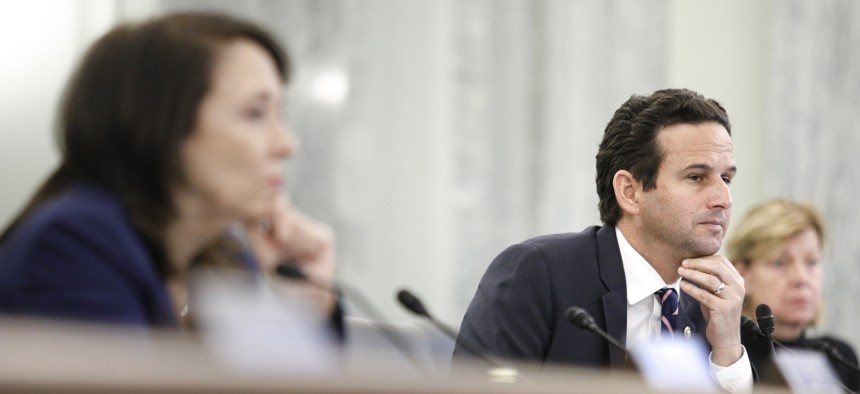Native American Advocates Discuss Barriers To Broadband Before Senate

WASHINGTON, DC - DECEMBER 15: Senator Brian Schatz (D-HI) looks on after asking a question during a Senate Commerce, Science, and Transportation oversight hearing. (Photo by Tom Brenner-Pool/Getty Images)
A Senate Committee hearing focused on the digital divide in rural tribal areas, and where federal programs are falling short.
A bevy of witnesses elucidated the longstanding challenges Native American communities face in overcoming the digital divide before the Senate Committee on Indian Affairs on Wednesday, calling attention to the inadequate basic telecommunications infrastructure.
Hosted by Chairman Sen. Brian Schatz, D-Hawaii and Vice Chairman Sen. Lisa Murkowski, R-Alaska, the discussion centered on establishing stronger broadband access in tribal communities across the U.S.
Witnesses described common barriers Native American communities face. Some of the issues that transcended tribes included problems accessing distance learning, remote work, emergency services, and telehealth resources.
“We have no black fiber that even comes close,” said the Honorable Manuel Heart, Chairman of the Ute Mountain Ute Tribe. His community, based in remote western regions in Colorado and Utah, simply lack the physical broadband infrastructure to support internet connections.
Heart added that satellite connectivity is often used as a substitute solution, but tends to be unreliable.
“We as tribal nations need to access the internet…[and] the broadband equity for all 574 tribes,” he said.
Ensuring stronger telecommunications connection and reliability within rural and tribal areas was one objective of President Joe Biden’s large scale Infrastructure Bill passed in 2021. About $2 billion in federal funding was directly allocated to Native American tribes to help build out broadband, pulling from a total of $65 billion toward broadband investment nationwide.
Another resource for Native American communities to access to help implement stronger broadband infrastructure are awards under the the National Telecommunications and Information Administration within the Department of Commerce. NTIA reviews applications submitted within the Tribal Broadband Connectivity Program, which distributes grants from its $980 million in funding.
Several witnesses at the Senate hearing yesterday pointed out a major flaw within this program: not every tribe has the internet access necessary to apply for government aid.
“We should make sure that there are not reporting barriers for these grant funds,” William Smith, the Chair of the National Indian Health Board, said. He noted that making grants intended for these communities more accessible will enable tribal equity in broadband access.
Matthew Rantanen, the co-chair of the Technology Task Force within the National Congress of American Indians, said that an initial lack of broadband access precluded scores of tribes from applying for federal grants for rural utilities. He noted that only half of Native American tribes were able to apply.
“The window was very, very short for tribes to be able to apply,” Rantanen said. “They did not have access to even attend some of the webinars and the informational pieces to learn how to apply.”
A critical component of closing the digital divide within Native American communities is the coordination between state and tribal governments. Hallie Bissett, the executive director of the Alaska Native Village Corporation Association, said that government entities will also have to work with private landowners to expedite permitting processes for broadband construction projects.
“Coordination is going to be key to deploy some of these funds,” Bissett said. She also highlighted the challenging geographical terrain that many tribal communities live on, which demands more operational and capital resources, namely within communities in Alaska.
“The longer this goes on with absolutely no fibre and no middle mile network into our villages, the more pronounced this problem is going to be,” Bissett said.
Bissett recommended more oversight to improve accountability in broadband deployment and funding disbursement transparency to promote local broadband development and longstanding equity.
She pointed out a need for a subagency within Alaska’s Office of Broadband Deployment to oversee these details, and suggested that the Federal Communications Commission adopt a similar program.
“The office should constantly monitor the digital divide, establish guidelines for funding accountability to ensure the efficient and expeditious disbursement of funds wherever they are needed most,” she said. Environmental scans and data mapping efforts, along with accurate pricing analyses, are also paramount in deploying broadband across tribal land.
“We know the divide is there and the divide is very real,” Murkowski concurred, adding that broadband affordability contributes to the digital divide as much as geographic area does. “When we haven’t addressed the issue of affordability, we haven't done anything to improve the access.”






